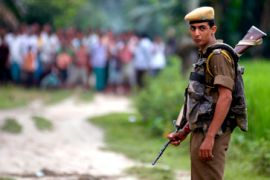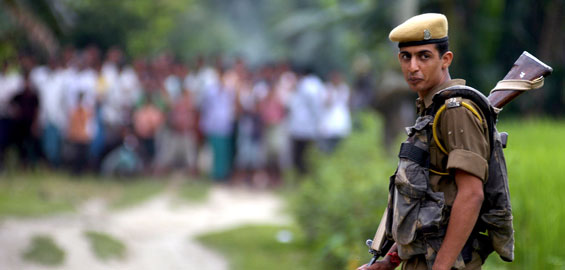India’s troubled northeast
Myriad of conflicts in region’s seven states have left more than 50,000 dead.

 |
| India’s army is struggling to tackle a myriad of armed groups in the northeast [File: EPA] |
More than 50,000 people are believed to have been killed, and many more displaced, by the violent unrest that has beset the northeastern states of India since the country’s independence in 1947.
Many of the conflicts have their roots in the extraordinary diversity of tribes – there are more than 400 different tribals or sub-tribal groups – religions, ethnicities and cultures in the region’s seven states.
Several armed groups have been battling for autonomy for their state, district or tribal homeland, while others have targeted rival religions or migrants.
The people of the so-called “Seven Sisters” states have many long-simmering grievances including poor governance, corruption and poverty.
Waves of migration from East and West, culminating with an influx of migrants from other parts of India to work as administrators, plantation workers and cultivators during British rule, have created this melting pot.
When Bangladesh achieved independence in 1971 the result was economic disaster for the northeastern states. Their inland water, road and railway communications with the rest of India were abruptly severed and they lost access to any port.
Although the central government has made substantial investment in economic development this has not improved the lot of most people.
There has also been some anger at a recent influx over the borders from neighbouring Myanmar, Nepal and Bangladesh.
Low intensity war
In the states of Assam and Manipur there is effectively a low intensity war between government forces and separatists.
The United Liberation Front of Asom (ULFA) launched a campaign for an independent Assam in 1979 attacking security forces, politicians and railway construction workers. At least 10,000 people have been killed in separatist violence.
 |
| Thousands of people were displaced by clashes in Assam in October 2008 [EPA] |
The group held talks with the government in 2006 leading to a truce, but it quickly collapsed and the attacks resumed.
Bodo tribesmen have also demanded their own separate state within India, but in 2005 the National Democratic Front of Bodoland signed a ceasefire with the government.
Since then there have been violent clashes between Bodo tribesmen and Muslim settlers, predominantly from Bangladesh. In the latest clashes in October 2008 dozens of people were killed and thousands lost their homes.
In the tiny state of Manipur on the border with Myanmar, several independence groups have been battling the army.
Tribal groups, mainly Nagas and Kukis, have been fighting for separate homelands since 1974. Tensions between the tribal groups have also resulted in a number of secondary conflicts.
One assessment found that there was as many as 18 separate active groups fighting the government in the state.
There are few job opportunities in Manipur providing the separatist movements – one of the most prominent of which is the People’s Revolutionary Party of Kangleipak which wants all non-Manipuris out of the state – with thousands of potential recruits.
Bengalis attacked
There are two main separatist rebel groups in Tripura state, the National Liberation Front of Tripura (NLFT) and the All Tripura Tiger Force (ATTF).
Both want independence for the tribal areas of the state, and the removal of Bengali immigrants. Attacks on Bengalis in northern Tripura have displaced up to 100,000 people.
 |
| Troops are battling two separatists groups in Tripura province [File: EPA] |
Another major cause of anger in Tripura has been the building by India of a fence along the border with Bangladesh, during which tens of thousands of people were evicted from their homes.
The conflict in Nagaland is India’s oldest and has been credited with inspiring others in the region.
Nagas, a loose collection of about 30 tribes, have fought since 1947 for a separate homeland that includes parts of the predominantly Christian state of Nagaland as well as areas in Manipur, Assam and Arunachal Pradesh.
India says creation of a greater Naga state might spark violence in other states, while analysts say peace with the Nagas is crucial for a broader resolution of the strife in the northeast.
The states of Arunachal Pradesh and Mizoram have been relatively peaceful in recent years but indigenous armed groups have continued to carry out some attacks.
Several tribal groups are increasingly involved in criminal and extortion activities in Meghalaya state.
New Delhi has acknowledged that the region’s difficulties will not be solved through military might.
In 2004, the government announced it would speak to any group willing to disarm leading to an increased level of dialogue with the various separtist organisations.
But the sheer number of such groups has caused some of them to step up attacks as the government has negotiated with rivals.